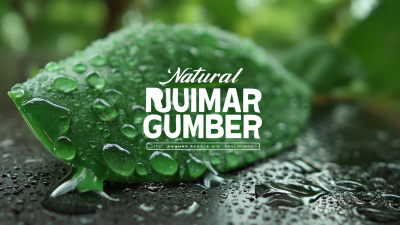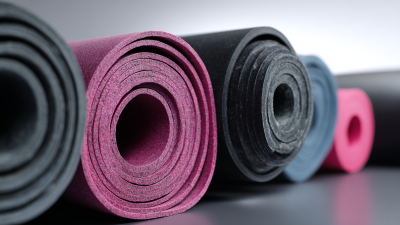Exploring Innovative Alternatives to Polyisoprene Rubber in Modern Manufacturing
In the rapidly evolving landscape of modern manufacturing, the quest for sustainable and efficient materials has led to a thorough exploration of alternatives to traditional materials like Polyisoprene Rubber. While Polyisoprene Rubber has long been heralded for its elasticity and versatility, the increasing demand for environmentally friendly and cost-effective solutions has sparked innovation in the industry. This blog will delve into the latest strategies for discovering and implementing alternative materials that can match or exceed the performance of Polyisoprene Rubber. By examining cutting-edge developments and exploring the potential of bio-based and synthetic materials, we aim to illuminate the path forward for manufacturers seeking to balance performance with sustainability. Join us as we explore the top strategies that promise to redefine the material landscape in contemporary manufacturing.

Benefits of Sustainable Materials in Manufacturing
The shift towards sustainable materials in manufacturing has gained significant momentum, particularly as industries seek alternatives to polyisoprene rubber. According to a report by the World Economic Forum, the adoption of sustainable materials can reduce overall carbon emissions by up to 30% in manufacturing processes. Utilizing materials such as bio-based polymers or recycled composites not only decreases environmental impact but also opens pathways for innovation in product design and functionality. Companies like Unilever and Nike have already begun integrating these alternatives into their production lines, leading to enhanced brand loyalty among environmentally conscious consumers.
**Tips for Transitioning to Sustainable Materials:**
1. Conduct a material audit to assess current supplies and identify areas where sustainable options can be integrated.
2. Collaborate with suppliers who specialize in eco-friendly materials to discover new developments and cost-effective solutions.
3. Educate your team about the benefits of sustainability not just for the environment but also for long-term profitability and market competitiveness.
By prioritizing sustainable materials, manufacturers not only align with consumer preferences but potentially enhance operational efficiency and brand reputation. Implementing these innovative alternatives represents a forward-thinking approach that can reshape the future of manufacturing.
Exploring Innovative Alternatives to Polyisoprene Rubber in Modern Manufacturing
This chart illustrates the potential market share of various sustainable materials used as alternatives to polyisoprene rubber in modern manufacturing. The data reflects the increasing interest in eco-friendly materials over traditional rubber solutions.
Advantages of Biodegradable Rubber Alternatives
In the quest for sustainable manufacturing, biodegradable rubber alternatives are emerging as a compelling option, particularly in applications traditionally dominated by polyisoprene rubber. According to a recent report by the International Rubber Study Group, the global demand for sustainable rubber solutions is projected to grow at a CAGR of 5.4% from 2023 to 2030, signaling a robust shift towards environmentally-friendly materials. Biodegradable rubbers, derived from natural sources such as guayule and dandelion rubber, present unique advantages, including reduced environmental impact and decreased reliance on fossil fuels.

One significant benefit of biodegradable rubber is its ability to decompose naturally within a few years, compared to the hundreds of years polyisoprene may take. Research published in the Journal of Cleaner Production indicates that the use of biodegradable rubber can cut down landfill waste by up to 30%. Additionally, these materials exhibit comparable physical properties to conventional rubbers, enabling manufacturers to maintain performance standards while embracing sustainability. With increasing consumer awareness and regulatory pressures, integrating biodegradable rubber into production processes not only aligns with eco-friendly practices but also enhances brand reputation in a competitive market.
Enhancing Performance: The Case for Alternative Elastomers
The quest for alternative elastomers to polyisoprene rubber has gained momentum in modern manufacturing, driven by the need for enhanced performance, sustainability, and cost-efficiency. Recent studies indicate that alternatives like thermoplastic elastomers (TPEs) showcase superior mechanical properties and chemical resistance compared to traditional polyisoprene. According to a report by Research and Markets, the global TPE market is projected to reach $34 billion by 2027, reflecting a compound annual growth rate (CAGR) of 5.7%. This growth underscores the increasing preference for materials that not only meet performance requirements but also align with environmentally conscious production practices.
In addition, bio-based elastomers, derived from renewable resources, are emerging as viable competitors. The European Bioplastics Association reveals that the bioplastics market, including bio-based elastomers, is expected to exceed 2.4 million tons by 2024. These alternative materials offer a lower carbon footprint and can be engineered to achieve comparable or improved properties relative to polyisoprene, thereby addressing both environmental concerns and performance standards. As industries prioritize innovation, the shift towards these advanced elastomers could redefine manufacturing paradigms, leading to more sustainable and efficient production methodologies.
Cost-Effectiveness of Innovative Rubber Solutions
In the quest for cost-effective manufacturing solutions, exploring alternatives to polyisoprene rubber has become increasingly relevant. Traditional materials often drive up production costs, making the search for innovative rubber solutions a high priority. With the global carbon black market projected to grow from $2.54 billion in 2025 to $35.21 billion by 2032, at a CAGR of 4.7%, the demand for superior alternatives continues to rise. Manufacturers are now considering biomaterials and synthetic rubbers that not only reduce costs but also enhance performance and sustainability in production processes.
Furthermore, the tire retreading market, expected to exceed $1.93 billion by 2033 with a CAGR of 6.55% from 2023 to 2033, highlights the increasing importance of innovative rubber solutions. By integrating advanced materials into tire retreading, manufacturers can significantly cut expenses while maintaining product integrity. Additionally, advancements in rubber O-ring markets and automotive suspension systems offer opportunities for reduced manufacturing costs and improved efficiency. As the industry evolves, embracing these innovative alternatives will be crucial for companies looking to stay competitive while optimizing their supply chains.
Exploring Innovative Alternatives to Polyisoprene Rubber in Modern Manufacturing - Cost-Effectiveness of Innovative Rubber Solutions
| Alternative Material | Cost per kg (USD) | Durability (cycles) | Temperature Resistance (°C) | Environmental Impact (CO2 kg/kg) |
|---|---|---|---|---|
| Bio-based Synthetic Rubber | 3.50 | 500,000 | 120 | 0.5 |
| Thermoplastic Elastomers (TPE) | 4.00 | 400,000 | 150 | 0.3 |
| Silicone Rubber | 5.00 | 300,000 | 200 | 0.2 |
| Natural Rubber Blends | 2.00 | 350,000 | 100 | 0.4 |
| Recycled Rubber Products | 1.50 | 250,000 | 80 | 0.1 |
Environmental Impact: Reducing Footprint with New Materials
The growing awareness of environmental challenges has prompted industries to seek alternatives to traditional materials like polyisoprene rubber. Recent studies indicate that the production of synthetic rubber contributes approximately 30 million tons of CO2 emissions annually, emphasizing the urgent need for more sustainable options. Innovative materials such as natural rubber, bio-based polyols, and thermoplastic elastomers are gaining traction, offering lower carbon footprints and promising performance characteristics.

One notable alternative is sustainable natural rubber, which can reduce greenhouse gas emissions by up to 90% compared to synthetic counterparts. Studies have shown that sourcing this material from responsibly managed plantations not only minimizes ecological impact but also supports local economies. Furthermore, advancements in bio-based polyols derived from renewable resources have shown potential to decrease reliance on fossil fuels in rubber production, aligning with the global shift towards sustainable manufacturing practices. The transition to these innovative materials not only reduces environmental footprints but also signals a commitment to responsible production in the modern manufacturing landscape.
Related Posts
-

How to Optimize the Use of Normal Butyl Rubber for Enhanced Industrial Performance
-

Exploring Sustainable Alternatives to Best Natural Gum Rubber for Global Buyers
-

Unleashing the Potential of Synthetic Rubber: A Game Changer for Global Buyers
-

Solutions for Achieving Optimal Performance with Best Santoprene Rubber
-

Navigating Global Trade Certification for Laser Cutting Silicone Rubber Solutions
-

Top 10 Thermoplastic Rubber Manufacturers from China at the 137th Canton Fair

